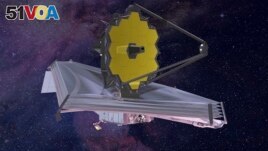26 January 2022
The American space agency NASA says its powerful James Webb Space Telescope has successfully reached its final position in orbit around the sun.
James Webb fired its rocket thrusters Monday for nearly five minutes to push the spacecraft into position about 1.6 million kilometers from Earth, NASA said in a statement.

This 2015 artist's rendering provided by Northrop Grumman, via NASA, shows the James Webb Space Telescope. (Northrop Grumman/NASA via AP)
The agency describes James Webb as "the largest and most powerful space science telescope ever built." It is meant to add to the discoveries of past telescopes, while gathering more in-depth data on the early development of the universe.
The orbiting observatory launched from French Guiana about a month ago. Its final position is known as the second Sun-Earth Lagrange point, or L2. This is a point where the gravitational forces of the sun and Earth balance each other. This will permit the telescope to stay in line with Earth as it orbits the sun.
Sun shield to keep telescope hot and cold
A large sun shield separates the telescope into hot and cold sides. One side will take in light and heat, the other will be shielded and remain cold.
The side with the telescope's science instruments needs to stay cold because it will be seeking heat signals from very distant objects, NASA explains. That side is expected to operate at about 225 degrees below zero Celsius.
The hot side – which NASA says is designed to operate at about 85 degrees Celsius – holds the telescope's solar power system and communications and other equipment.
The sun shield successfully opened about a week and a half after James Webb launched. A few days later, the observatory's nearly seven-meter mirror was deployed. The mirror, a collection of 18 different pieces, still needs to be perfectly aligned before the telescope can operate. NASA expects that process to take about three months.
New generation telescope
James Webb is designed to detect infrared waves – a kind of electromagnetic energy that cannot be seen with the human eye. The telescope's instruments were built to find infrared waves through gas and dust in an effort to observe distant objects.
The infrared detection system and the telescope's scientific instruments will need to get cold enough to perform effectively. If all goes well, NASA says it expects James Webb to produce its first "early release observations" sometime in June.
NASA officials leading the project have been pleased with how things have progressed so far. "Webb is officially on station," Observatory Manager Keith Parrish told reporters. He said the telescope's orbital arrival came after "a remarkable 30 days" in space.
James Webb is considered NASA's new generation telescope after the Hubble and Spitzer space telescopes. Hubble was launched more than 30 years ago and Spitzer was deployed in 2003. Both of those telescopes led to numerous discoveries and provided more detailed, colorful space images than ever before.
But the new telescope aims to help scientists learn about all periods of the universe's history dating back to just after the Big Bang event, about 13.8 billion years ago. It is also designed to study exoplanets - planets that orbit stars other than the sun.
"We're one step closer to uncovering the mysteries of the universe," NASA Administrator Bill Nelson said in a statement. "And I can't wait to see Webb's first new views of the universe this summer," he added.
I'm Bryan Lynn.
Bryan Lynn wrote this story for VOA Learning English, based on reports from NASA, The Associated Press and Reuters.
We want to hear from you. Write to us in the Comments section, and visit 51VOA.COM.
____________________________________________________Words in This Story
thruster – n. an engine that produces propulsion by releasing a jet of fluid or a stream of particles
shield – n. a piece of equipment that serves as a protective cover or barrier
align – v. to put things in an exact line or make them parallel
detect – v. to discover or notice something
remarkable – adj. very unusual or noticeable in a way that is admired
view – n. things that can be seen from a place